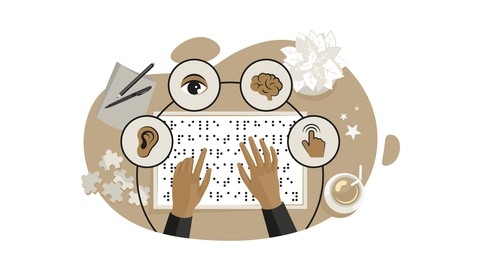UX writing is the art and science of crafting user interface (UI) text that guides users seamlessly through digital products and experiences.
It’s the voice of your product, guiding users, providing helpful information, and ultimately shaping their overall experience.
Learning UX writing can open doors to a rewarding career in tech, allowing you to directly impact the usability and success of websites and applications.
With the growing demand for UX writers, it’s no surprise that you’re searching for the best UX writing courses on Udemy to develop your skills.
However, sifting through the numerous options available can be overwhelming.
You need a course that not only covers the fundamentals but also provides practical exercises and real-world examples to help you build a strong portfolio.
After extensive research and analysis, we’ve identified the Introduction To UX Writing course as the best overall choice on Udemy.
This comprehensive course provides a solid foundation in UX writing principles, covering topics like microcopy, user research, and accessibility.
It’s packed with practical exercises and real-world examples, ensuring you gain the skills and knowledge needed to excel in this field.
While the Introduction To UX Writing course is our top recommendation, there are other excellent courses on Udemy that cater to specific needs and learning styles.
Continue reading to explore our curated list of top-rated UX writing courses on Udemy, designed to help you find the perfect fit for your journey into the world of UX writing.
Introduction To UX Writing
This “Introduction to UX Writing” course teaches you how to write for websites and apps in a way that is easy for people to understand.
You will learn the basics of UX writing and how it is different from traditional copywriting.
The course explains how people think and act online, using ideas like Hick’s Law, which says that too many choices make it hard for people to decide.
This will help you make websites that are easy to use.
You will also learn the qualities of good UX writing, such as being clear, concise, and helpful.
You will understand how to write in a friendly, conversational style that matches the website or app’s brand.
It’s like learning the rules of a game to play it well.
The course helps you practice what you learn by giving you realistic tasks.
You will write different kinds of messages and text, like calls to action that tell people what to do, placeholder text that guides users, and error messages that explain what went wrong.
For example, you will learn how to write clear and helpful messages for when someone enters a wrong password or when a page is not found.
This practice helps you learn faster.
Transitioning Into UX Writing
This UX writing course provides a solid foundation for entering the field.
You will learn about the daily life of a UX writer, including their tasks and the skills necessary for success.
The course highlights both the rewards and challenges of this career path and guides you on how to start your journey.
You will also learn practical strategies for securing a UX writing job.
The course covers the entire application process, from creating a strong resume and portfolio to mastering interview techniques.
It also offers valuable tips for handling home assignments, a common step in the hiring process.
Microcopy & UX Writing: The Complete Course
This UX writing course teaches you how to write clear, concise microcopy for any user interface (UI).
You will learn how to create a consistent brand voice and write in a conversational style that engages users.
The course covers everything from writing button copy to crafting helpful error messages.
You will learn to write microcopy for specific elements like buttons, forms, success messages, and even empty states.
You will discover how to turn potentially frustrating situations, like encountering a 404 page, into positive experiences.
The course teaches you how to write 404 pages that are friendly, helpful to users, and beneficial for businesses.
You will gain a deeper understanding of why 404 pages matter and learn the three essential elements that every 404 page needs.
User Research And Testing For UX Writing
This course teaches you the essentials of user research and testing specifically for UX writing.
You start by learning about the “why” behind user research and its importance in creating effective UX copy.
You quickly dive into the “how” with techniques like Competitor Analysis, Conversation Mining, and Target Group Observation.
You then learn how to conduct Focus Groups and User Interviews to gather in-depth user insights.
The course then shifts gears to validating your initial research.
You discover how to use Search Term Analysis, A/B Testing, and Comprehension Surveys to test your writing’s effectiveness.
You also explore Card Sorting and Usability Testing to understand how users interact with your content.
The course even covers lesser-known methods like Cloze Tests and Highlighter Testing, providing a full toolbox of research techniques.
Through this course, you gain the practical skills to conduct your own user research and confidently apply the findings to improve your UX writing.
You learn how to identify user needs, test different approaches, and validate your writing choices, ensuring your copy resonates with your target audience.
Accessible UX Writing
This accessible UX writing course teaches you to write for users with disabilities.
You learn why accessibility is important and how to write content everyone understands.
You discover how screen readers work and how to write alt text, which describes images for people who can’t see them.
This course improves your UX writing skills and makes your content more inclusive.
The course has two parts.
In Course I, you learn about accessible on-screen text.
You explore topics like context and clarity, logical order of elements on a screen, and how to use emojis in an accessible way.
You practice writing clear buttons and links, vital for screen reader users.
Course II covers accessible alt text.
You learn where to add it, how to write effective descriptions, and the importance of using keywords for clarity.
You also explore the role of repetition in accessibility and UX writing.
Each course includes projects to apply your new skills.
UX Writing In Practice: Documentation & Processes
This UX writing course teaches you practical skills you can use right away.
You will learn why documentation matters in UX writing and how to create your own using tools like Ditto, Frontitude, and Strings, or even a simple spreadsheet.
You will also learn how to use InDesign for UX writing documentation, an industry-standard tool.
The course then teaches you how to use UX writing in Agile projects.
You will learn about the issues you might face, how to manage expectations, and the realities of working with Agile.
You will also learn helpful tips for managing your UX writing throughout your Agile workflow, which will help you work better and faster.
UX Writing: Microcopy, User Research, Accessibility & More
This UX writing course takes you from the basics to crafting user-friendly content.
You learn the difference between UX writing and traditional writing and how to create a consistent tone and voice for your product.
You practice adapting your writing to different audiences and contexts.
Microcopy, the small details that can make a big difference, is a key focus.
You learn to write everything from button labels and placeholder text to error and success messages.
You also discover how to write clear tooltips, system messages, navigation labels, and confirmation messages.
This course goes beyond the writing itself to teach you about user-centered writing.
You discover how to understand your audience through user research techniques like user interviews, surveys, and card sorting.
You learn how to use tree testing and usability testing to make your writing even better.
The course also covers heatmaps and A/B testing so you can use data to make smart decisions about your writing.
You learn how to create user personas and map user journeys to understand how people use your product.
The course also teaches you about accessibility, so you can make your writing inclusive for everyone.
You learn how to make images accessible and use ARIA attributes to make your writing better for people with disabilities.
You also discover helpful tools to make sure your writing is easy for everyone to understand.
UX Writing: Finding Your Voice & Tone
This UX writing course is structured as a two-part series.
In the first part, you will discover the meaning of voice and tone in UX writing and why they are important.
You will learn how to define your brand’s identity and transform it into values that guide your writing.
The course then takes you through a clear process to establish your own writing guidelines.
The second part of the course guides you in creating a UX writing style guide.
This style guide acts as a roadmap for your writing, ensuring consistency and clarity for your users.
You will learn about the various parts of a style guide and acquire practical tips and tricks for building your own.








